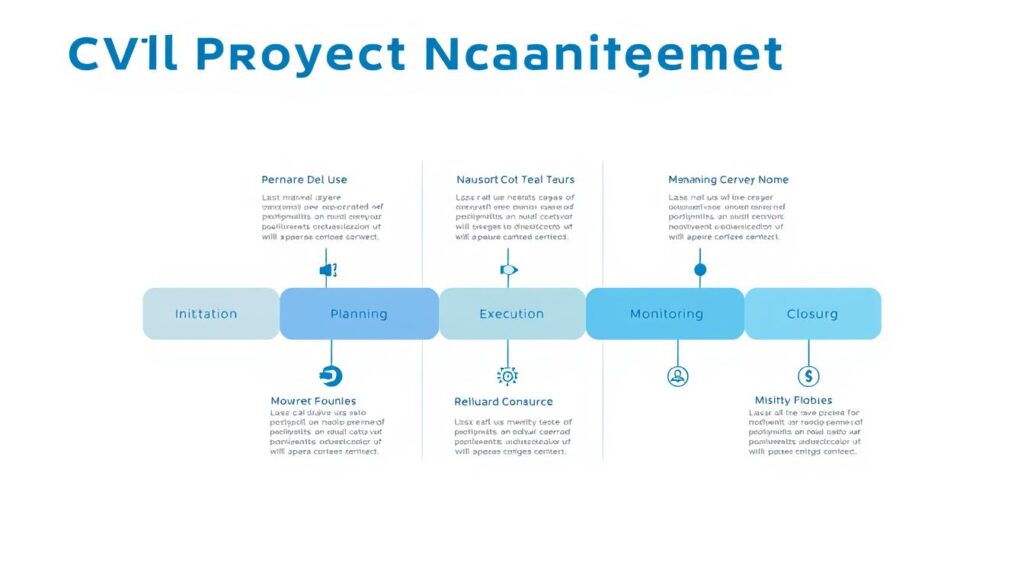Management in civil engineering forms the backbone of successful infrastructure development. It encompasses the coordination of resources, personnel, and processes to ensure projects are completed safely, on time, and within budget. From skyscrapers to bridges, effective management practices determine whether civil engineering projects succeed or fail in meeting their objectives.
This comprehensive guide explores the multifaceted nature of management in civil engineering, breaking down the essential roles, types, and best practices that drive successful project outcomes in this demanding field.
Key Roles in Civil Engineering Management
The Role of a Civil Manager
A civil manager serves as the central coordinator for engineering projects, bridging the gap between technical expertise and project execution. Their primary responsibility involves overseeing the entire project lifecycle from conception to completion while ensuring all stakeholders remain aligned with project goals.
Civil managers must possess both technical engineering knowledge and strong leadership capabilities. They translate complex engineering concepts into actionable plans, allocate resources effectively, and maintain quality standards throughout the project’s duration.
- Developing and implementing project management plans
- Coordinating with architects, contractors, and regulatory bodies
- Managing project budgets and timelines
- Ensuring compliance with safety regulations and building codes
- Resolving technical and logistical challenges
The 4 Roles of Management in a Construction Firm
Management in civil engineering encompasses four distinct but interconnected functions that form the foundation of successful project delivery:
Planning
Establishing project objectives, developing strategies, and creating detailed roadmaps for execution. This includes resource allocation, scheduling, and risk assessment to set the project up for success.
Organizing
Structuring teams, defining responsibilities, and establishing communication channels. This role ensures that the right people with the right skills are in the right positions to execute the plan effectively.
Leading
Motivating teams, resolving conflicts, and maintaining morale throughout the project lifecycle. Effective leadership ensures that all team members remain committed to project goals despite challenges.
Controlling
Monitoring progress, comparing actual performance against planned objectives, and implementing corrective actions when necessary to keep the project on track.

Need Expert Guidance for Your Engineering Project?
Our team of experienced civil engineering managers can help you implement effective management practices tailored to your specific project needs.
Types of Management in Civil Engineering
Civil Management vs. Construction Management
While often used interchangeably, civil management and construction management represent distinct approaches with different scopes and focuses:
| Aspect | Civil Management | Construction Management |
| Primary Focus | Overall infrastructure development including design, planning, and technical aspects | Execution phase of building projects with emphasis on on-site activities |
| Scope | Broader – encompasses entire project lifecycle from conception to completion | Narrower – primarily focused on the construction phase |
| Technical Involvement | Higher emphasis on engineering principles and technical design | Greater focus on building methods, materials, and labor management |
| Stakeholder Engagement | Works with government agencies, communities, and engineering teams | Primarily interfaces with contractors, suppliers, and on-site personnel |

Two Types of Construction Management
Within the construction management domain, two primary approaches have emerged to address different project needs and risk profiles:
Agency Construction Management
In this model, the construction manager acts as the owner’s representative and advisor without assuming financial risk for the project. The agency CM provides expertise and oversight while the owner maintains direct contracts with contractors.
Advantages
- Owner maintains greater control over project decisions
- Transparent fee structure with no hidden markups
- Independent advice without conflicting interests
- Flexibility to adapt to changing project requirements
Limitations
- Owner retains most financial risks
- Requires more owner involvement in project decisions
- May lead to more complex contract management
At-Risk Construction Management
In this approach, the construction manager assumes financial responsibility for the project’s completion, essentially guaranteeing a maximum price. The CM at-risk serves as both advisor during planning and general contractor during construction.
Advantages
- Transfers significant financial risk away from owner
- Provides cost certainty through guaranteed maximum price
- Single point of responsibility for construction quality
- Early contractor involvement improves constructability
Limitations
- Potentially higher management fees to cover risk
- Possible conflicts of interest in cost-saving decisions
- Less flexibility for major scope changes
Core Concepts in Civil Engineering Management
Civil Project Management
Civil project management involves the application of knowledge, skills, tools, and techniques to meet the specific requirements of infrastructure projects. It encompasses the entire project lifecycle from initiation through planning, execution, monitoring, and closure.

For example, in a bridge construction project, civil project management would involve initial feasibility studies, environmental impact assessments, detailed design planning, procurement of materials, coordination of construction activities, quality control inspections, and final commissioning.
Civil Information Management
Civil information management refers to the systems and processes used to collect, organize, store, and utilize data throughout a civil engineering project. This includes everything from design specifications and material properties to scheduling information and compliance documentation.
Effective information management has become increasingly critical as civil engineering projects grow in complexity. Modern approaches leverage Building Information Modeling (BIM), Geographic Information Systems (GIS), and integrated project management software to maintain a single source of truth for all project stakeholders.
“The difference between a successful civil engineering project and a troubled one often comes down to how effectively information is managed and communicated across teams.”
The 5 Pillars of Construction Management
Successful management in civil engineering rests on five fundamental pillars that provide structure and direction to project execution:

Planning
The foundation of project success, encompassing scope definition, resource allocation, risk assessment, and creating detailed roadmaps for execution. Effective planning anticipates challenges and establishes clear pathways to project completion.
Cost Management
The systematic approach to estimating, budgeting, financing, and controlling project costs. This pillar ensures that projects remain financially viable while delivering the expected value to stakeholders.
Time Management
The processes required to ensure timely completion of the project, including activity sequencing, duration estimating, schedule development, and progress monitoring to prevent delays.
Quality Management
The systems and procedures that ensure the project meets specified requirements and standards. This includes quality planning, assurance, and control throughout the project lifecycle.
Safety Management
The processes that protect workers, the public, and the environment from harm during construction activities. This pillar emphasizes hazard identification, risk assessment, and implementation of preventive measures.
Strengthen Your Project Management
Learn how our consulting services can help you implement these five pillars effectively in your next civil engineering project.
Functions and Importance of Management in Civil Engineering
Key Functions of Construction Management
Construction management in civil engineering encompasses several critical functions that ensure project success:

- Resource Allocation: Optimizing the distribution of labor, materials, equipment, and financial resources across project activities to maximize efficiency.
- Schedule Management: Developing, maintaining, and adjusting project timelines to ensure timely completion of interdependent activities.
- Cost Control: Monitoring expenditures, managing cash flow, and implementing cost-saving measures without compromising quality.
- Quality Assurance: Establishing standards, conducting inspections, and implementing corrective actions to maintain project quality.
- Risk Management: Identifying potential threats, assessing their impact, and developing mitigation strategies to protect project objectives.
- Stakeholder Coordination: Facilitating communication and collaboration among project owners, designers, contractors, regulatory agencies, and community representatives.
- Contract Administration: Managing agreements with suppliers, contractors, and consultants to ensure compliance with terms and conditions.
Why Engineering Management is Critical in Civil Engineering
The importance of effective management in civil engineering cannot be overstated. It directly impacts project outcomes in several key ways:

Effective management in civil engineering ensures that complex infrastructure projects are delivered safely, on time, and within budget while meeting quality standards. It serves as the bridge between technical engineering expertise and practical project execution, translating designs and specifications into tangible structures that serve communities for generations.
In an industry where projects frequently involve multiple stakeholders, substantial financial investments, and significant public impact, strong management practices provide the framework for navigating complexity and achieving successful outcomes. They help mitigate risks, optimize resource utilization, and ensure that engineering solutions effectively address the intended needs.
According to the Project Management Institute, organizations with mature project management practices complete 89% of their projects successfully, compared to just 36% in organizations with low project management maturity.

Best Practices in Civil Engineering Management

Implementing Effective Management Approaches
Successful management in civil engineering requires a combination of technical knowledge, leadership skills, and systematic approaches. The following best practices have been proven to enhance project outcomes:
- Integrated Project Delivery: Adopting collaborative approaches that bring together all stakeholders from the earliest project phases to align goals and optimize results.
- Lean Construction Principles: Implementing waste reduction techniques and continuous improvement processes to maximize value and efficiency.
- Advanced Planning Techniques: Utilizing methods like Last Planner System and Pull Planning to enhance schedule reliability and team coordination.
- Technology Integration: Leveraging BIM, drones, IoT sensors, and project management software to improve information flow and decision-making.
- Proactive Risk Management: Developing comprehensive risk registers and contingency plans before issues arise.
How can civil engineering managers improve stakeholder communication?
Effective stakeholder communication in civil engineering projects can be improved by establishing clear communication channels, holding regular progress meetings, creating accessible project dashboards, developing a comprehensive communication plan, and utilizing visual tools like BIM models to illustrate complex concepts. Tailoring communication approaches to different stakeholder groups is also essential.
What strategies help maintain budget control in large civil engineering projects?
Budget control in large civil engineering projects can be maintained through detailed initial cost estimation, implementation of earned value management systems, regular financial reviews, early identification of potential cost overruns, value engineering workshops, and maintaining adequate contingency reserves. Transparent reporting and prompt decision-making when issues arise are also critical factors.
How is digital transformation changing management in civil engineering?
Digital transformation is revolutionizing management in civil engineering through integrated BIM platforms that enable real-time collaboration, mobile applications that facilitate field data collection, AI and machine learning for predictive analytics, digital twins for asset management, and cloud-based project management systems that enhance information sharing. These technologies are improving decision-making, reducing errors, and increasing overall project efficiency.

Elevate Your Civil Engineering Management Practices
Our team of experienced consultants can help you implement these best practices and optimize your project management approach for better outcomes.
Conclusion: The Future of Management in Civil Engineering
Management in civil engineering continues to evolve as projects become more complex, stakeholder expectations increase, and new technologies emerge. The successful civil engineering manager of tomorrow will need to balance traditional project management fundamentals with innovative approaches that leverage data, collaboration, and sustainability principles.
By understanding the various roles, types, and best practices in civil engineering management, professionals can develop the comprehensive skill set needed to deliver infrastructure projects that meet technical requirements while creating lasting value for communities and stakeholders.
As the industry faces challenges like climate change, urbanization, and aging infrastructure, effective management practices will be more important than ever in ensuring that civil engineering projects are not only completed successfully but also contribute positively to addressing these global challenges.

Get Expert Guidance for Your Civil Engineering Projects
Ready to enhance your approach to management in civil engineering? Our team of experienced consultants is here to help you implement best practices tailored to your specific project needs.
